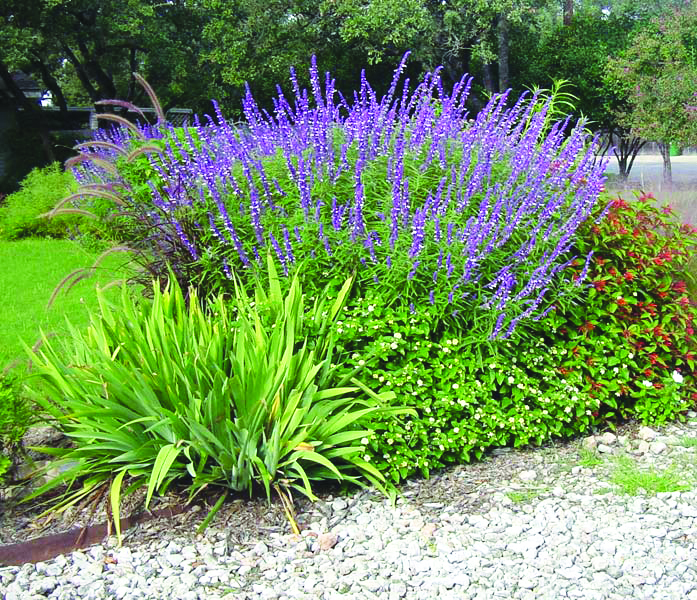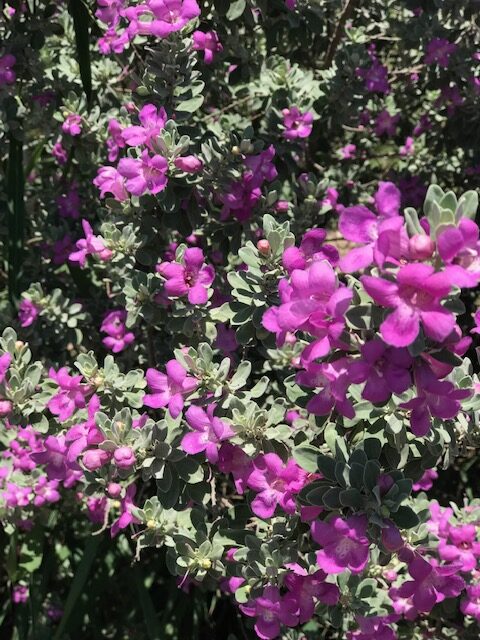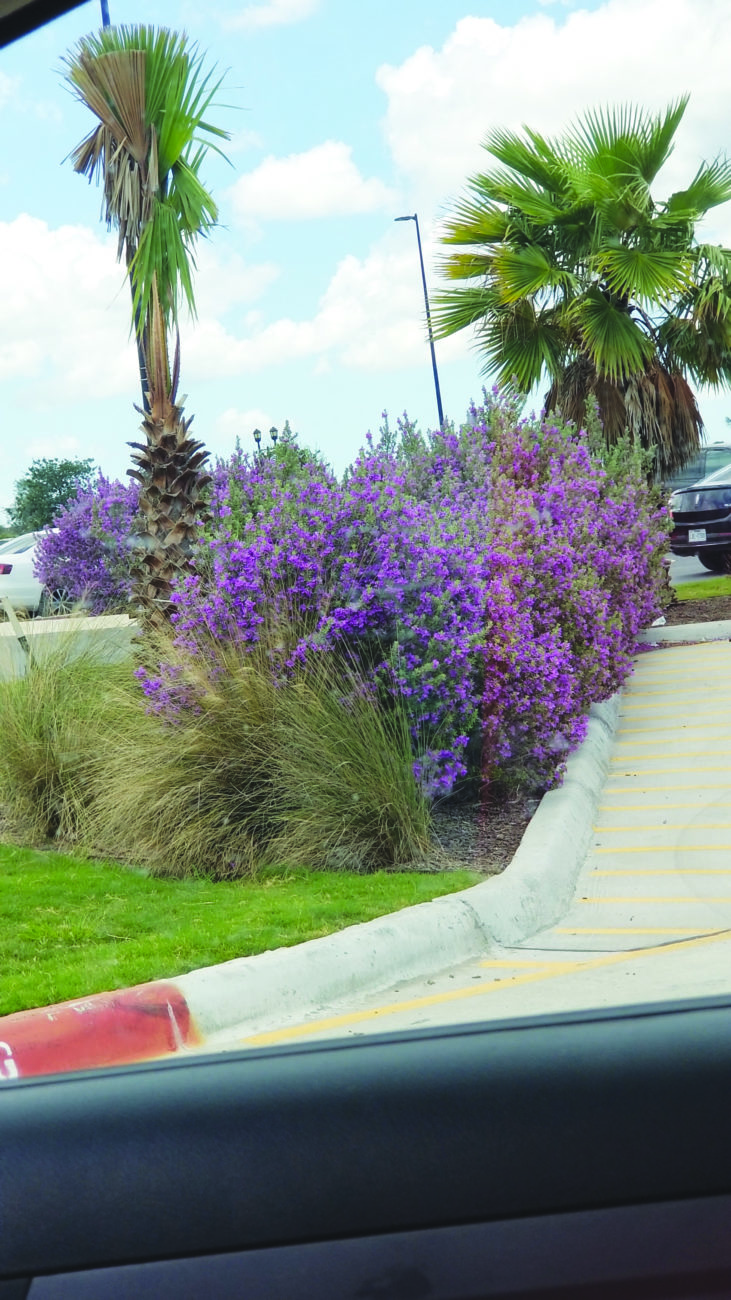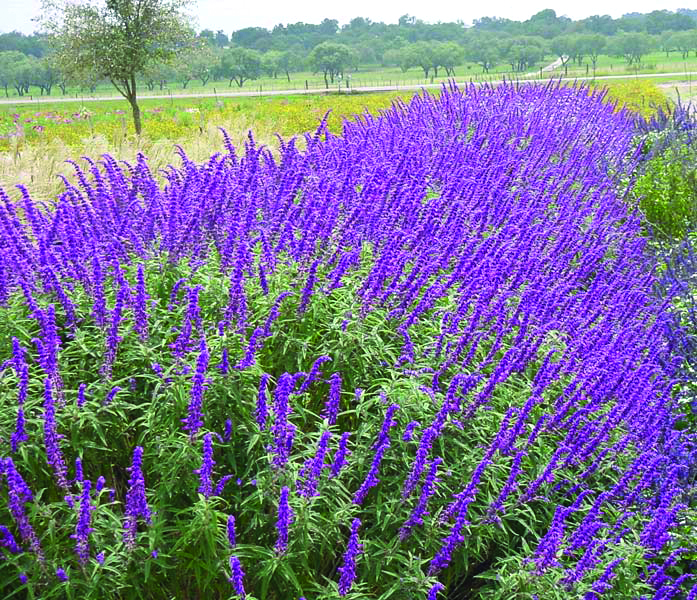Lori Murray and Bonnie Garcia, Cameron County Master Gardener, Texas Superstar Specialist
When Debbie Cox sent me a picture of Cenizo in bloom and suggested that the explosion of its flowers after our recent rains would make it a good topic for an article, I thought it was a great idea.
Little did I know that in my ignorance I would research sage and come up with a real melting pot of plants. Three hours on the computer later, I had much more information than I had expected and needed to let the topic sit overnight before my brain could deal with it!
What I’m going to describe today is in three parts: Texas Sage (the Barometer Bush), Mexican Bush Sage (which is actually a salvia), and culinary/garden sage.
Texas Sage is also known as purple sage, Texas Ranger, Texas Silverleaf, and Silverleaf. It’s the hardy, drought tolerant plant that springs into bloom for only a few days at a time, depending on rainfall and is featured in some of our music (“the sage in bloom…is like perfume.”)
The most common Texas sage – Leucophyllum frutescens – has soft leaves that are gray-green and silvery due to the many many tiny hairs that cover them and its flowers are a startling but dense light lavender. This is an easy care plant that makes a medium sized shrub in USDA plant hardness zones 8 – 11. It requires at least 4 – 6 hours of light per day during the sun’s peak period; full sun is even better.
It can be trimmed into a nice hedge, but if you overprune, it will become scraggly. It’s the ideal plant for rocky, gravelly soil or areas like slopes where the conventional plant does not grow. It needs regular deep watering to set its roots, but once established requires little more than whatever rainfall we get.
One word of warning if you are planting in clay: the cenizo must have good drainage or its roots will rot. Do not fertilize or add compost or you will not get as many blooms; the plant prefers dry but well-draining soil. Since it has little need for lots of water, it’s an excellent plant for xeriscaping. Homeguides author Lauren Miller advised that “the height of a Texas sage bush depends on its environment. It stays compact and short, up to 5 feet tall, in arid conditions. Plants tend to grow more than 8 feet tall in gardens where they receive water that supplements rainfall. Compact varieties are good for large containers. Shorter cultivars include “Compacta,” which has pink flowers.”
She also cautions that there are a multitude of different varieties of cenizo to choose from, differing not only in leaf and flower color, but also in height and width. So…be careful to get a variety that has the characteristics you want, especially when it comes to size.” This plant cannot be pruned down if it gets too large. The Lady Bird Johnson Wildflower Center reports that cenizo attracts – and is the larval host for – Theona Checkerspot and Calleta silkmouth butterflies. It also tells us that the Texas Sage’s habit of bloom in response to heat and relative humidity led to its nickname, “Barometer Bush.”
SOURCES:
Mexican Bush Sage
The Mexican Bush Sage was designated a Texas Superstar in 1997 and is an evergreen shrub in tropical locations. This Sage can tolerate temperatures down to 15 degrees but may die-back in the colder regions. This drought tolerant Mexican native prefers sunny, well-drained sites and will survive with no supplemental irrigation is most parts of the state.
This sage tends to get leggy and top heavy, however, if it has to reach for the sun. The plant normally grows 2 to 4 feet in height with a mounding growth habit. The plant’s stems stand out because they are white and woolly in appearance and the willow-like leaves are a fuzzy silver-grayish color. Mexican bush sage is native to Mexico and Central America and is a reliable perennial in the lower one third of Texas (zones 8b-10).
From autumn through winter, the Mexican bush sage will flower profusely producing flowers 6 to 12 inches long of white with lavender and purple calyces extending way beyond the foliage, making this one of the most attractive of the salvias. There’s also a form with solid purple spikes. For the most flowers in late summer and fall, the plant should be sheared several times during the summer months. The subsequent regrowth produces a sturdier more compact plant as well.
This plant has earned its stripes because of its drought tolerance, pest resistance, and adaptability to a wide range of well-drained soils, including alkaline clays and acidic sands. It has also been reported to be among the “deer proof” plants for the Texas Hill Country. Unlike the annual red salvia (Salvia splendens) which often succumbs to intense heat and drought, the Mexican Bush Sage actually thrives during our typical desert like summers.
This plant is attractive to bees, butterflies and/or birds and hummingbirds. In addition to their landscape appeal, the Mexican Bush sage can be used as a massed bedding plant, a container plant in large pots, as a part of a mixed perennial border, or as a landscape specimen. The stately spikes can also be used as dramatic cut flowers.
The Mexican Bush sage can be propagated from woody stem cuttings and by simple layering. After the flowers fade; seeds can be collected from a seed head/pod and allowed to dry.
Sources:
www.gardenguides.com/…information-mexican-bush-sage.html
www.plantanswers.com/arcadia_pages/plant_of_the_month/ floridata.com/ref/s/salv_leu.cfm
www.ehow.com/how_5631911_care-mexican-sage-bush.html











